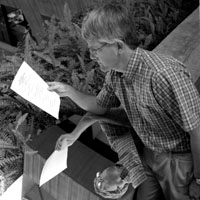 |
|
The Science of Run II:
The Main Injector will fire up the Tevatron for making new discoveries
"With the new Main Injector and our detector upgrades, weíve taken a facility that we already have, and without spending billions and billions of dollars, weíve essentially remade it into a much more powerful physics facility," said Fermilab theoretical physicist Joe Lykken. "We could be looking ahead to a golden age of particle physics at Fermilab." Lykken and other scientists envision breakthroughs into new physics beyond the Standard Model of Elementary Particles, with the Main Injector enabling increased luminosity levels at the Tevatron (at least 20 times as many proton-antiproton collisions as in Run I); and with improved data-handling and tracking capabilities at the CDF and DZero detectors (at least 20 times the data generated in Run I). The greater the number of collisions, the greater the chances for new discoveries; the greater the data-handling and detector sophistication, the greater the ability to record those discoveries and analyze them in exquisite detail. Now, consider the possibilities. Lykken capsulized the Run II wish list: 1.More top quarksñProducing thousands of top quarks, instead of just a hundred or so, means achieving a new level of detail in studying the massive elementary particle discovered at Fermilab in 1995. More precise measurements of the top and of the W boson (one of the force-carriers in the Standard Model) might point the way toward the discovery of the Higgs bosonñthe brass ring on the particle physics carousel. Nobel laureate and Fermilab Director Emeritus Leon Lederman has dubbed it "The God Particle." 2.New b PhysicsñThe bottom quark is next heaviest after the top. As the worldís highest-energy particle accelerator, the Tevatron can conduct b physics in realms inaccessible to the lower-energy "B-factories" (which manufacture B-mesons made from bottom quarks). The Tevatron is thus uniquely suited to investigate instances of CP violation (anomalies between matter and antimatter) exclusive to the bottom quark. "If you were to guess where we would first see evidence of new physics from Run II," Lykken predicted, "the safest bet is probably CP violation in b physics." 3.New Particle DiscoveriesñIncreasing Tevatron luminosity also increases the possibility of creating higher-energy collisions that could produce particles heavier than the top, opening the door to supersymmetry. The many different models within the supersymmetry (SUSY) framework all propose that every particle in the Standard Model has one or two superpartner particles, which are much heavier and have a different spin. "If supersymmetry is the right way to extend the Standard Model," Lykken said, "then we know there are lots and lots of particles out there waiting to be discovered. And if SUSY tells us some of those particles are not too heavy, we have a chance of seeing at least one or two of those particles in Run II." While Run II is projected as a two-year excursion into the borderland of new physics, it will also serve as a test run for the new configuration of Fermilabís accelerator, and a measurement of the experimental reach with the higher luminosity at the Tevatron. How far will the new reach exceed the grasp of Run I? Quite likely, far enough to extend an open-ended invitation for Run III, or "extended Run II," as it was described by Fermilab Director John Peoples at the recent Department of Energy Annual Review: a continuation of Run II, evolving with upgrades to increase the Tevatronís luminosity, while the experiments continue and the detectors keep churning out data, taking this scientific expedition beyond the borderlands of new physics and into even more exciting new realms. "Basically, we hope to keep running the accelerators until weíre told to stop," Lykken said. The stop order is expected to come at some point after the Large Hadron Collider begins operating at CERN, the European particle physics laboratory in Geneva, Switzerland. But as Lykken points out, that debut wonít be before 2006ñand it could be as late as 2008 before LHC begins generating what he calls "real physics results." That leaves Fermilab with nearly a decade on the frontier of high energy physics contemplating the ultimate challengeñfinding the Higgs with a machine that wasnít designed to find it, whereas LHC and the late Superconducting Super Collider were dedicated to the Higgs quest. The last major undiscovered Standard Model particle, the Higgs is "in some senses the most important particle," Lykken explained. "Itís supposed to do a lot of neat tricks. Itís supposed to be related to the process that gives mass to quarks, leptons, and the W and Z bosons. Itís the particle that talks to all the other particles in a very important and unknown way." Lykken said a 75-member working group from theoretical physics and from the CDF and DZero detectors spent a year studying whether the Tevatron was capable of discovering the Higgs. The groupís conclusion: current measurements of top mass and other Standard Model parameters predict a fairly light Higgs, probably lighter than the top itself; so if the number of collisions in the Tevatron can be nudged beyond the Main Injectorís capabilities, finding the Higgs before LHC "is not a crazy idea." "Even if we donít find direct evidence of the Higgs," Lykken said, "we
can point the way for LHC and say, ëHereís where to look.í But taking the Tevatron,
and pushing it to the point of actually discovering the Higgsñthat would be incredible,
a great discovery for particle physics, a triumph for Fermilab. The Tevatron could
become a legend in particle physics."
|
| last modified 6/1/1999 email Fermilab |
FRLsDFx9eyfrPXgV
 Run II of
the Tevatron offers Big Science that even a banker can love: the promise of making
spectacular discoveries without making a spectacle of the budget.
Run II of
the Tevatron offers Big Science that even a banker can love: the promise of making
spectacular discoveries without making a spectacle of the budget.